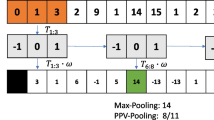Abstract
Dimension reduction techniques are at the core of the statistical analysis of high-dimensional and functional observations. Whether the data are vector- or function-valued, principal component techniques, in this context, play a central role. The success of principal components in the dimension reduction problem is explained by the fact that, for any \(K\le p\), the K first coefficients in the expansion of a p-dimensional random vector \(\mathbf{X}\) in terms of its principal components is providing the best linear K-dimensional summary of \(\mathbf X\) in the mean square sense. The same property holds true for a random function and its functional principal component expansion. This optimality feature, however, no longer holds true in a time series context: principal components and functional principal components, when the observations are serially dependent, are losing their optimal dimension reduction property to the so-called dynamic principal components introduced by Brillinger in 1981 in the vector case and, in the functional case, their functional extension proposed by Hörmann, Kidziński and Hallin in 2015.

Similar content being viewed by others
References
Brillinger DR (1981) Time Series: Data Analysis and Theory. Holden-Day, San Francisco
Forni M, Lippi M (2011) The generalized dynamic factor model: one-sided representation results. J Econom 163:23–28
Forni M, Hallin M, Lippi M, Reichlin L (2000) The generalized dynamic factor model: identification and estimation. Rev Econ Stat 82:540–554
Forni M, Hallin M, Lippi M, Reichlin L (2005) The generalized dynamic factor model: one-sided estimation and forecasting. J Am Stat Assoc 100:830–840
Forni M, Hallin M, Lippi M, Zaffaroni P (2015) Dynamic factor models with infinite-dimensional factor space: one-sided representations. J Econom 185:359–371
Forni M, Hallin M, Lippi M, Zaffaroni P (2017) Dynamic factor models with infinite-dimensional factor space: asymptotic analysis. J Econom 199:74–92
Hallin M, Lippi M (2013) Factor models in high-dimensional time series: a time-domain approach. Stoch Process Appl 123:2678–2695
Hörmann S, Kidziński Ł (2017) freqdom.fda: functional time series: dynamic functional principal components. https://CRAN.R-project.org/package=freqdom.fda
Hörmann S, Kidziński Ł, Hallin M (2015) Dynamic functional principal components. J R Stat Soc B 77:319–348
Karhunen K (1946) Zur Spektraltheorie Stochastischer Prozesse. Ann Acad Sci Fennicæ Ser. A.I Math Phys 34:1–7
Karhunen K (1947) Über lineare Methoden in der Wahrscheinlichkeitsrechnung. Ann Acad Sci Fennicæ Ser. A.I Math Phys 37:1–79
Loève M (1955) Probability theory. Van Nostrand, Princeton
Panaretos V, Tavakoli S (2013) Fourier analysis of stationary time series in function space. Ann Stat 41:568–603
Peña D, Yohai VJ (2016) Generalized dynamic principal components. J Am Stat Assoc 11:1121–1131
Peña D, Smucler E, Yohai VJ (2017) Forecasting multiple time series with one-sided dynamic principal components. arXiv:1708.04705v1
Author information
Authors and Affiliations
Corresponding author
Additional information
Siegfried Hörmann: Research partially supported by the Communauté francaise de Belgique, Actions de Recherche Concertées, Projets Consolidation 2016–2021, and Interuniversity Attraction Poles Programme (IAP-network P7/06) of the Belgian Science Policy Office.
Rights and permissions
About this article
Cite this article
Hallin, M., Hörmann, S. & Lippi, M. Optimal dimension reduction for high-dimensional and functional time series. Stat Inference Stoch Process 21, 385–398 (2018). https://doi.org/10.1007/s11203-018-9172-1
Received:
Accepted:
Published:
Issue Date:
DOI: https://doi.org/10.1007/s11203-018-9172-1




